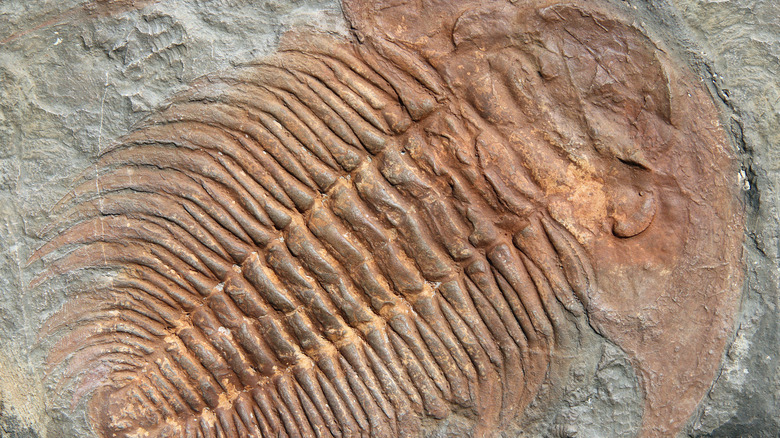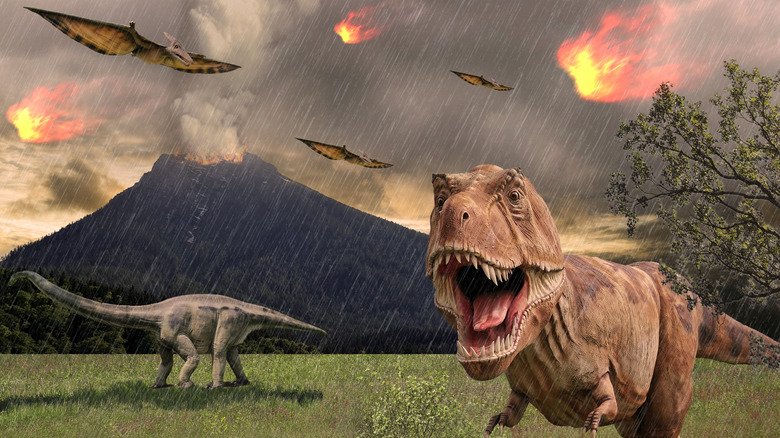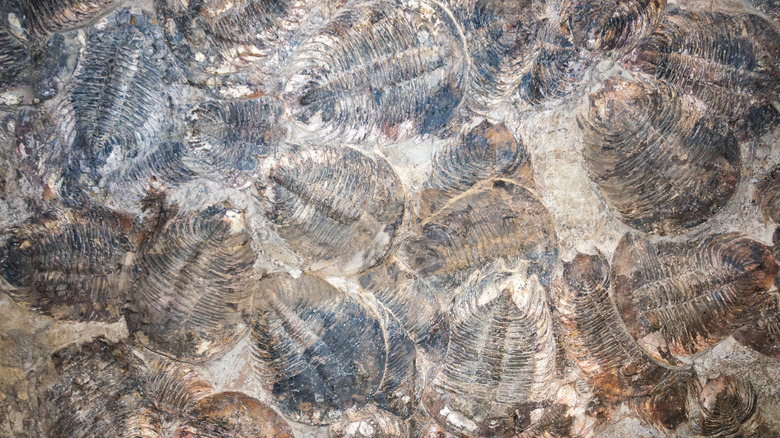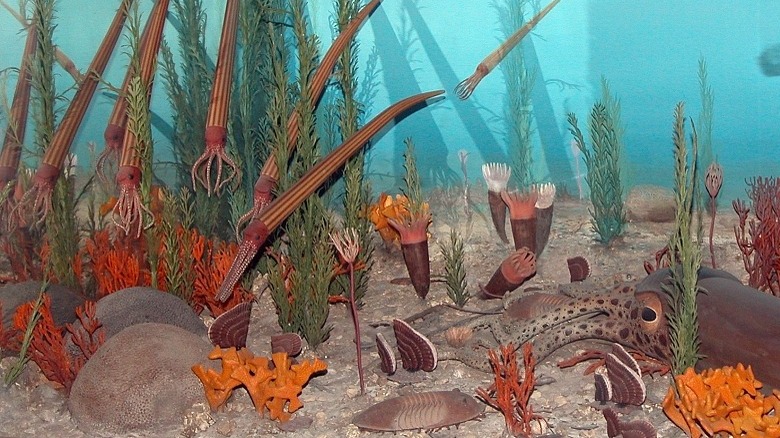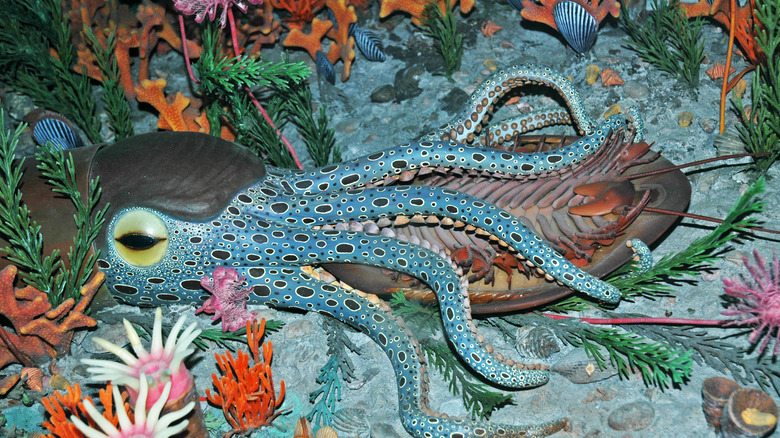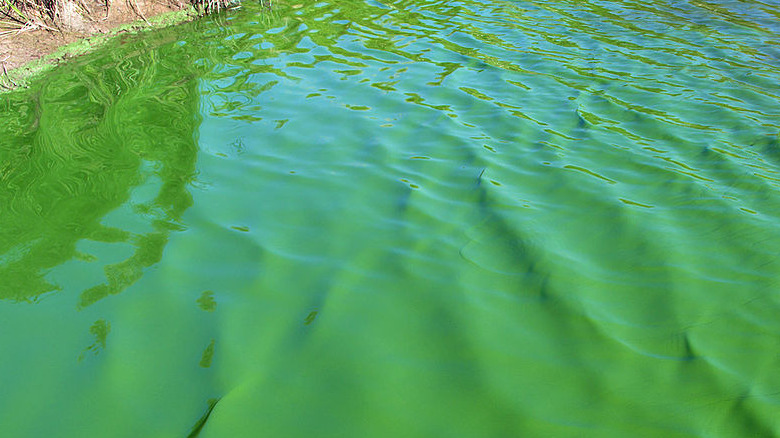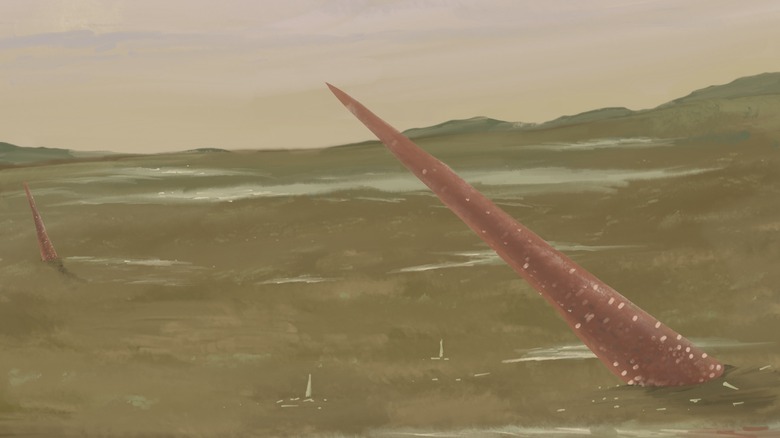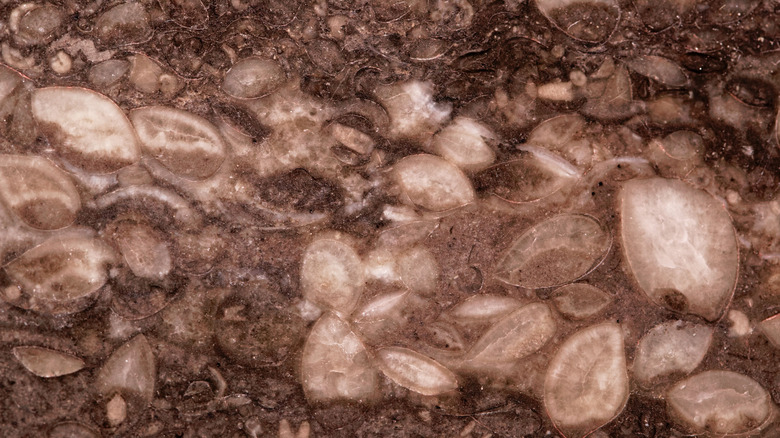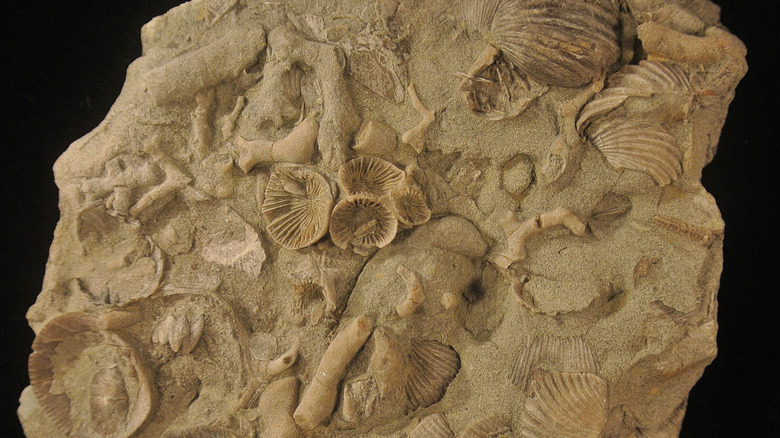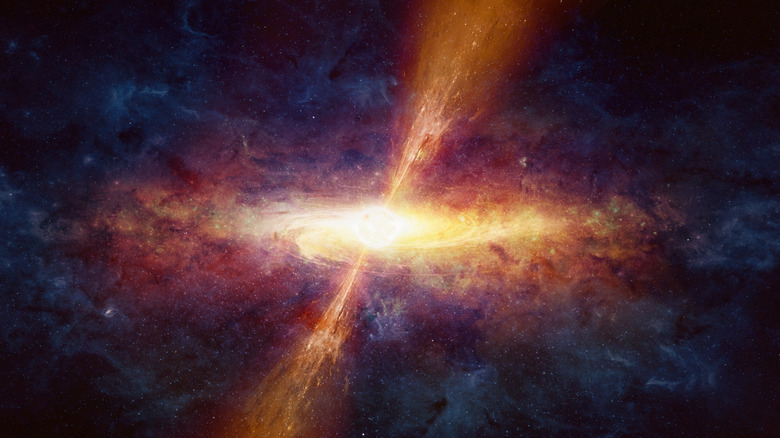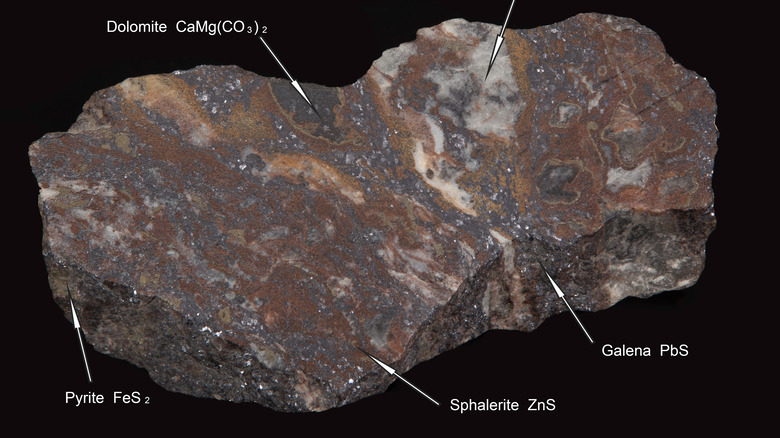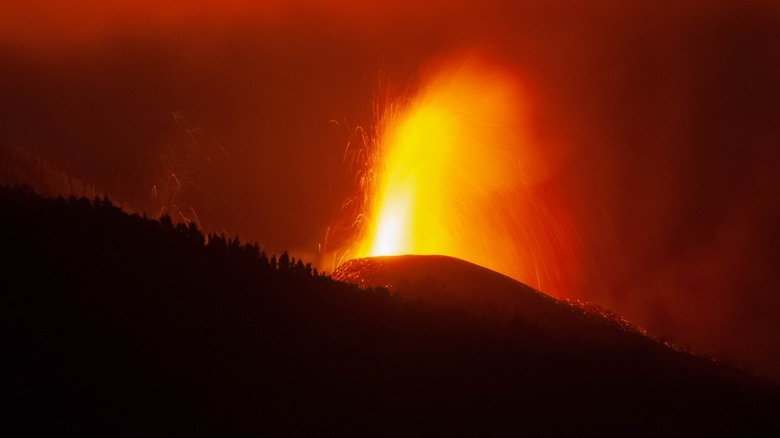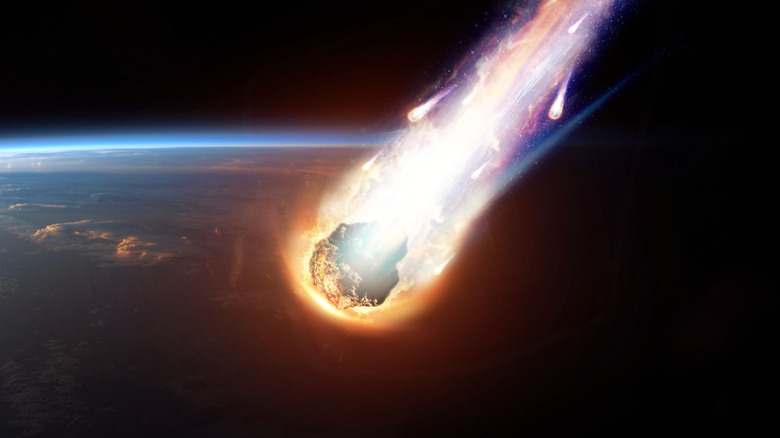The Tragic Truth About The Ordovician-Silurian Mass Extinction
When people talk about mass extinction events, the one that usually gets brought up is the Cretaceous-Tertiary (K-T) extinction event, which took place about 66 million years ago and wiped out the non-avian dinosaurs. This isn't surprising, given how pop culture frequently references this mass extinction whenever the spotlight is on the prehistoric biodiversity that disappeared as a result. However, the K-T extinction event is just one of five major extinctions in Earth's history. The first one, the Ordovician-Silurian mass extinction event, took place nearly 400 million years earlier.
Per National Geographic, the Ordovician Period (which happened 485.4 to 443.8 million years ago) saw an explosion of new species on the planet over the span of 30 million years. During the so-called Great Ordovician Biodiversification Event, a significant "evolutionary surge" took place in which complex multicellular species thrived in the planet's marine ecosystems (via Paleoworld). According to the Sam Noble Oklahoma Museum of Natural History, this was because animals hadn't quite made the transition from their aquatic environments to land yet.
The Ordovician-Silurian extinction, which experts say happened in two "pulses," was so devastating that it left only about 15% of the planet's species alive. However, despite killing off so many organisms, it didn't turn out to be quite as impactful or world-changing as the other, more well-known extinction events. This is the tragic truth about the Ordovician-Silurian mass extinction. Discover how it may have happened, the species that it eliminated, and how life on Earth rebounded after it.
The first of the big five mass extinctions
Despite being called the first of Earth's "Big Five" mass extinctions, the Ordovician-Silurian extinction wasn't confined to a single catastrophic event (via the Sam Noble Oklahoma Museum of Natural History). To be more specific, there were actually two different extinction pulses separated by about a million years, with the first taking place around 443.8 million years ago during the so-called Hirnantian Age of the Ordovician (per Britannica).
Of course, the idea of the Ordovician-Silurian extinction event being Earth's first major extinction stems from available fossil evidence — meaning that in reality, it may not have actually been the planet's first brush with multi-species extinction.
As Discover Magazine notes, there were likely many unfavorable environmental conditions that could have brought about earlier (and similarly lethal) mass extinctions. After all, single-celled organisms dominated the planet even before the first multicellular species came to be. Thus, it would be unrealistic to assume that the prehistoric planet's microbial life didn't have to endure similar circumstances.
The second-largest mass extinction in history
While the Ordovician-Silurian extinction event has the dubious distinction of being the first of the Big Five, it also happens to be in second place when it comes to the level of devastation wrought upon Earth's prehistoric species.
At this point in Earth's history, for approximately 3 billion years, bacteria, archaea, and other simple, single-celled organisms dominated the planet (via Discover Magazine). Meanwhile, multicellular life had just started to emerge and multiply, steadily becoming prevalent in the planet's bodies of water. And by the end of the Ordovician-Silurian extinction event, a staggering 85% of all species that flourished prior were killed off.
That percentage may sound impressive, and to be fair, it really is. Consider the fact that the far more popular K-T extinction event was only about half as severe as the Ordovician-Silurian event as far as the number of species affected was concerned (per Britannica). Interestingly, the Ordovician-Silurian event turned out to be somehow less severe that the Permian-Triassic extinction, which killed off not only 95% of aquatic life, but also 70% of terrestrial species as well (via Britannica).
What did Ordovician biodiversity look like?
There may seem to be a rather bitter sense of irony in the fact that the Ordovician-Silurian extinction event followed the Great Ordovician Biodiversification Event, which has been called "one of the most important major turnovers in the evolution of the marine biosphere" (via Lethaia).
Calling this explosion of species diversity an "event" can be a bit of a misnomer, though, as it didn't really happen in a snap (as the name might imply). Rather, it took place over the course of tens of millions of years, with multicellular life slowly and steadily populating Earth's marine environments. However, scientists have said that the Great Ordovician Biodiversification Event didn't result in the creation of new phyla (though the Bryozoa, a large group of marine invertebrates, may be the sole exception). This means that it wasn't quite as remarkable as the Cambrian radiation or Cambrian explosion that took place about 541 million to 530 million years ago, marking the beginning of the lineages of nearly all the animals thriving in the present day (via PBS).
Regardless, by the time the Ordovician-Silurian extinction event took place, the planet's seas were already populated by a spectacular variety of aquatic fauna, including bivalves, brachiopods, bryozoans, conodonts, corals, echinoderms, graptolites, and trilobites (per Discover Magazine).
The first extinction pulse: the Late Ordovician glaciation
While paleontologists generally agree that the first pulse of the Ordovician-Silurian extinction event involved massive glaciation, it's still hard to pinpoint exactly why it happened in the first place (via Discover Magazine).
According to National Geographic, a possible explanation may have been the rise of the Appalachian Mountains in North America. Such a significant geological change certainly meant weathering on a drastic scale — and thanks to the physical and chemical processes involved, the planet likely experienced a sharp, severe drop in global temperatures due to the amount of carbon dioxide that was being sucked out from Earth's atmosphere by the emerging silicate rocks. At the same time, sea levels drastically decreased, leading to the destruction of numerous warm marine habitats (via Discover Magazine) and the rise of potentially toxic materials from the deepest depths of Earth's waters (via the Annual Review of Earth and Planetary Sciences). Another theory involves the explosion of plant life on the planet, which could have hastened silicate weathering while absorbing greenhouse gases. With these sudden hostile shifts in Earth's climate and aquatic environments, many species were unable to cope and adapt in time to survive.
Long story short: climate change was most likely the driver of the first extinction pulse.
The second extinction pulse: worldwide anoxia and euxinia
The first extinction pulse came to an end when the Late Ordovician glaciation came to an abrupt stop (per the Annual Review of Earth and Planetary Sciences). At this point, sea levels started to rise anew, along with the stagnation of oceanic circulation and the stabilization of the global climate. While this may sound like a good thing, this actually spelled doom for the creatures that somehow managed to survive the first extinction pulse by adapting to a cooler climate (via Discover Magazine). This time around, they needed to evolve in order to thrive in the warmer temperatures.
By the time the Silurian Period began to roll in (starting with the Rhuddanian Age, which spanned 443.8 million to 440.8 million years ago), enough factors were already in play to bring about a second pulse of extinction. As Nature Communications explains, the second extinction pulse is said to be strongly linked to oxygen depletion (anoxia) and toxic sulfide production (euxinia) happening all over the world.
Interestingly, while this second pulse "marked the end of a long interval of ecologic stasis," its long-term ecologic effects weren't as significant as the less deadly mass extinction events that followed it. Additionally, it took a few million years for Earth's surviving multicellular organisms to adapt once more.
Which species were hit hardest by the extinction event?
The Ordovician-Silurian extinction event decimated the populations of virtually every major taxonomic group in existence at the time, according to Discover Magazine. Moreover, about a third of the bryozoan and brachiopod families from that period were wiped out by the mass extinction. Other groups of fauna that suffered massive losses were the echinoderms (the phylum under which today's sea stars, sea urchins, and sea cucumbers belong), conodonts (eel-like invertebrates distantly related to the hagfish), and graptolites (colonial animals that lived in interconnected tube systems).
Meanwhile, some groups of fauna simply never managed to bounce back to their pre-extinction levels of biodiversity. The iconic trilobite is an example. According to the Annual Review of Earth and Planetary Sciences, approximately half of the surviving trilobite genera were wiped out during the first pulse. By the time the second pulse took place, less than a third of the previously existing trilobite genera remained. Another group of fauna that never quite managed to recover were the inarticulate brachiopods. Out of 15 identified families, six were wiped out — and their numbers didn't improve even after the second pulse.
How did the world recover?
During the first few million years of the Silurian Period, the species that survived the Ordovician-Silurian extinction event steadily began to recover (via the Proceedings of the National Academy of Sciences). Based on data collected on genus occurrences across the paleocontinent called Laurentia, experts determined that as rapidly as over five million years, organisms living at the bottom of the prehistoric seas were able to raise their numbers back to pre-extinction levels. For comparison, the numbers suggest that this level of recovery should have been possible across 20 million years.
Researchers from the Chinese Academy of Sciences and the National Museum Wales stated that based on fossil evidence from the prehistoric seafloor, it appears that sponges (and plankton) became some of the dominant survivors after the Ordovician-Silurian extinction event (per The Indian Express).
Interestingly, the researchers noted that the sponges weren't just mere survivors. Based on how large and complex they appeared from the preserved skeletons and soft tissues, those species were actually thriving after the mass extinction. The experts had some ideas as to how this was possible. "We think the sponges thrived because they can tolerate changes in temperature and low oxygen levels, while their food source (organic particles in the water) would have been increased enormously by the death and destruction all around them," said lead author Joe Botting (via The Indian Express).
Deadly, but not quite impactful
Despite the fact that the Ordovician-Silurian extinction event is the second deadliest mass extinction of all time, it doesn't hold a candle to the Permian-Triassic extinction (aka the Great Dying) in terms of how devastating its impact was on the planet (via the Annual Review of Earth and Planetary Sciences). And while it was far more lethal than the K-T extinction event, the Ordovician-Silurian extinction event didn't kill off any "mascot groups" that were as popular as, say, ammonites or dinosaurs.
Discover Magazine provides some insight into why the Ordovician-Silurian extinction event didn't have as much of an impact. A closer look at the numbers would reveal that while it did kill off 85% of the species that existed at the time, 40% of genera and 75% of families still managed to survive. Compare that to the extinction event that eradicated the dinosaurs, which essentially wiped the slate clean and paved the way for mammals to become the new dominant species on the planet.
In other words, due to the way that the high-level taxonomic groups were dispersed across Earth, there were enough survivors from the affected genera and families to repopulate and preserve the "evolutionary status quo," to the point where the fossil record from before and after the Ordovician-Silurian extinction event are nearly indistinguishable. As University of California, Berkeley paleobiologist Seth Finnegan put it: "You need to be a specialist to tell what side of the Ordovician-Silurian boundary you're on." (via Discover Magazine).
The gamma-ray burst hypothesis
It's hard to pinpoint exactly what caused such a massive species die-out as the Ordovician-Silurian extinction event. Unsurprisingly, a number of theories have emerged, exploring the various circumstances that could have made it possible — and one of the more popular ideas about its origin raises the possibility of radiation from a "huge cosmic explosion" as one of the catalysts (via BBC News).
In a study published in the International Journal of Astrobiology, researchers explained that gamma-ray bursts (GRB) "produce a flux of radiation detectable across the observable Universe" and could realistically cause extensive damage to life on Earth. Based on their calculations, at least one GRB could have occurred within the last billion years, and it could have contributed to the Ordovician-Silurian extinction event.
Aside from the GRB being the potential trigger for the Late Ordovician glaciation, it could have also damaged the Earth's ozone layer. In fact, a 10-second burst would have been more than enough to destroy half of the planet's protection against the powerful ultraviolet rays of the sun. Without such a protective layer, the sun's radiation "could have killed off much of the life on land and near the surface of oceans and lakes."
Were certain species wiped out by toxic metals?
While the scientific community has specifically linked the Late Ordovician glaciation to the first extinction pulse, the drastic change in global temperatures probably wasn't the only reason why so many species died out. A sharp, sudden change in the chemistry of the ocean may have had a major hand in it as well.
According to a study published in Nature Communications, when the oxygen in the prehistoric oceans was depleted following massive geological and climate changes, it may have caused toxic metals from the deepest depths to emerge, having a significantly negative effect on marine ecosystems. Specifically, dangerous levels of arsenic, iron, and lead may have surfaced, possibly causing "deadly deformities in tiny, plankton-like creatures that teemed in Earth's ancient seas" (via National Geographic).
As the researchers explained in their paper, the naturally occurring metals on the ocean floor tend to dissolve along with a drop in seawater oxygen — and when the fossil plankton were exposed to high amounts of these toxic metals, they were likely poisoned, developing "aberrant morphologies" that ultimately doomed them.
Was it caused by volcanic activity?
One of the things that sets the Ordovician-Silurian extinction event apart from other mass extinctions is the idea that a global cooling kicked it off. In a sense, this makes the first of the Big Five a bit of an outlier, as other extinction events were thought to have been brought about by rising global temperatures due to extreme volcanic activity (via Discover Magazine).
Research from 2020 published in Geology suggests that the first pulse of the Ordovician-Silurian extinction event wasn't actually caused by global glaciation, but by volcanic activity. According to the study, volcanic eruptions could have brought about the oxygen depletion and global warming that drove the majority of Earth's species to extinction. Additionally, the resulting carbon dioxide from the volcanic activity could have been enough to drive both pulses, even though they were a million years apart (via The New York Times).
The researchers based their idea on the recently discovered mercury deposits dating back to that time period, hinting at volcanic eruptions possibly being a factor in the extinction event. Furthermore, because of the sulfur aerosol expulsions and basalt flows that follow volcanic eruptions, such natural events can also trigger global cooling. While additional evidence is required to support this theory, it's still an interesting (and feasible) way of looking at it.
Could it have been a meteorite?
Perhaps the most iconic imagery depicting the K-T extinction event involves dinosaurs from the Cretaceous Period looking cluelessly (and helplessly) as a gigantic fireball descends from the prehistoric sky. Indeed, the K-T extinction event is by far the only massive species die-off with an established link to a "major asteroid impact" (via National Geographic). That said, what are the chances that a similar impact was actually the cause behind the Ordovician-Silurian extinction event? Based on fossil evidence, pretty slim.
As Britannica explains, there is no evidence of a meteorite hitting Earth around the time of the Ordovician-Silurian extinction event, mainly because scientists haven't found any concentration of iridium that would suggest such an event.
Experts have linked meteorites to the Ordovician Period not as a catalyst for extinction, but as a possible reason behind the Great Ordovician Biodiversification Event. Specifically, the so-called "Ordovician meteor event" has been suggested to play "a crucial role" in accelerating the Ordovician species boom. However, a 2017 paper in Nature Communications plainly states that the two events were not related.
